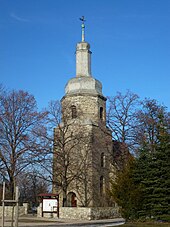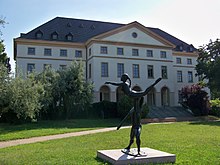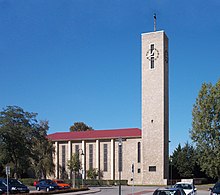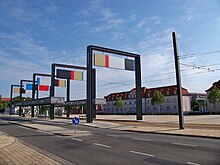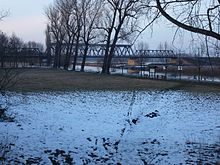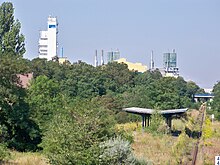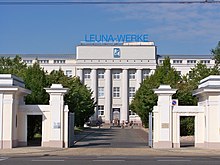Leuna
| coat of arms | Germany map | |
|---|---|---|

|
Coordinates: 51 ° 19 ′ N , 12 ° 1 ′ E |
|
| Basic data | ||
| State : | Saxony-Anhalt | |
| County : | Saalekreis | |
| Height : | 99 m above sea level NHN | |
| Area : | 87.71 km 2 | |
| Residents: | 13,908 (Dec. 31, 2019) | |
| Population density : | 159 inhabitants per km 2 | |
| Postal code : | 06237 | |
| Primaries : | 034204, 03461, 03462, 034638, 034639, 034446, 03638 | |
| License plate : | SK, MER, MQ, QFT | |
| Community key : | 15 0 88 205 | |
City administration address : |
Rathausstrasse 1 06237 Leuna |
|
| Website : | ||
| Mayoress : | Dietlind Hagenau (independent) | |
| Location of the city of Leuna in the Saalekreis | ||
Leuna is a town in the Saalekreis in Saxony-Anhalt . The place is best known for its chemical industry and less for its character as a garden city .
geography
The city of Leuna is located on the Saale , five km south of Merseburg , 20 km south of Halle (Saale) and 30 km west of Leipzig .
Neighboring communities
Leuna borders in the north on Schkopau , in the east on Schkeuditz in north Saxony , in the south on Markranstädt in the district of Leipzig , Bad Dürrenberg and Weißenfels in the Burgenland district , Braunsbedra in the west and Merseburg in the northwest.
Districts
| Locality | Area km² |
Residents | Districts |
The localities of Leuna (clickable map) |
|---|---|---|---|---|
| Peace Village | 3.29 | 309 | Peace Village | |
| Günthersdorf | 3.29 | 1359 | Günthersdorf | |
| Horburg-Maßlau | 3.97 | 537 | Horburg and Maßlau | |
| Kötschlitz | 5.40 | 995 | Kötschlitz, Möritzsch and Zschöchergen | |
| Kötzschau | 16.77 | 802 | Kötzschau, Rampitz , Schladebach , Thalschütz and Witzschersdorf | |
| Kreypau | 12.38 | 157 | Kreypau, Wölkau and Wüsteneutzsch | |
| Leuna | 12.68 | 8289 | Daspig, Göhlitzsch, Kröllwitz, Leuna, Ockendorf , Rössen | |
| Rodden | 3.61 | 244 | Rodden and pissing | |
| Spergau | 10.80 | 1088 | Spergau | |
| Zöschen | 7.20 | 973 | Zöschen and Zscherneddel | |
| Two | 7.31 | 298 | Dölkau , Göhren and Zweimen | |
| Leuna | 86.70 |
The population of the central village of Leuna relates to December 31, 2008, that of the other districts to June 30, 2017.
history
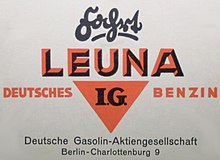
The village of Leuna in the north of the city gave its name to the city. Like its neighboring towns of Ockendorf, Rössen and Göhlitzsch, this belonged to the Merseburg high-school Merseburg office until 1815 , which had been under Electoral Saxon sovereignty since 1561 and belonged to the secondary school principality of Saxony-Merseburg between 1656/57 and 1738 . Kröllwitz and Daspig were stiftmerseburgische fiefs, as enclaves in the Official Merseburg in the Electorate of Saxony Office Weissenfels ( castle Werbener judgment seat) schriftsässig were. The decisions of the Congress of Vienna the villages Leuna, Ockendorf, Rössen, Göhlitzsch, Daspig and Kröllwitz came in 1815 to Prussia and were 1,816 Merseburg in the administrative district of Merseburg of the Province of Saxony allocated.
In 1917 a special purpose association was formed through the merger of the rural communities of Leuna-Ockendorf, Rössen, Göhlitzsch, Daspig and Kröllwitz, and on July 1, 1930, the large community of Leuna. The Merseburg ammonia works , the Leuna works of BASF , and IG Farben since 1926 , the largest hydrogenation works in Germany , had been in Leuna since 1917 . The plant produced Leuna gasoline from coal , covered part of the Wehrmacht's fuel needs and was the source of aviation fuel for the Air Force .
At the end of 1944, the neighboring Leunawerke had a workforce of 27,000, including 16,500 foreign workers and prisoners of war. The city of Leuna was also regularly affected by the violent air raids on the Leuna works from May 12, 1944 to April 5, 1945. There were three high bunkers (20 m high) in Leuna-Ort , two flat bunkers , further smaller bunkers and two air raid tunnels for "foreign workers" on the Saale slope .
"There were hardly any apartments, streets, squares and public buildings that were not affected by the destruction." The destruction balance for Leuna-Ort at the end of the war: 525 apartments were completely destroyed, 453 badly damaged, 1467 moderately to slightly damaged. The infrastructure (roads, sewage, electrical energy, gas and water supply, tram and rail network) was largely destroyed. A city reconstruction agency organized the clearing of rubble and construction work. 80,000 cubic meters of rubble had to be removed.
On November 1, 1945 Leuna received city rights.
The current district of Ockendorf is of Germanic origin and celebrated its 1100th anniversary in 1999. The baroque Gnadenkirche is located in Ockendorf itself. It was built around 1710–1714 and is considered a real gem among the city's churches.
In 1936 the Saale near Leuna was straightened.
Incorporations
The Leuna-Kötzschau administrative community was founded as part of the comprehensive introduction of unified municipalities in Saxony-Anhalt in order to avoid incorporation into Merseburg . On December 31, 2009, the unified community of Leuna was formed from the previously independent communities Friedensdorf, Günthersdorf, Horburg-Maßlau, Kötschlitz, Kötzschau, City of Leuna, Kreypau, Rodden, Spergau, Zöschen and Zweimen. As a result, the number of inhabitants of Leuna has more than doubled and the area has increased sixfold.
politics
City council
Since the local elections on June 4, 2019, the city council has consisted of 28 council members and the mayor.
| Christian Democratic Union of Germany (CDU) | 7 seats |
| Alternative for Germany (AFD) | 5 seats |
| The left | 4 seats |
| Social Democratic Party of Germany (SPD) | 3 seats |
| Free Democratic Party (FDP) | 1 seat |
| INSTEAD of party | 1 seat |
| Alliance for Leuna (BfL) | 5 seats |
| Single applicant Engelmann | 1 seat |
| Individual applicant Krüger | 1 seat |
mayor
In March 2015 Dietlind Hagenau was re-elected with 73% of the votes cast.
coat of arms
Blazon : "In silver over a black-grooved green wall covered with a silver ploughshare, a black-grooved red chimney, accompanied by stakes of three six-pointed green stars."
flag
The flag is green-silver (white) striped lengthways with an applied coat of arms in the middle.
Town twinning
Wesseling from North Rhine-Westphalia is the twin town.
Culture and sights
Buildings
In the "Garden City of Leuna", 102 workers 'houses, 153 masters' houses, 165 employees 'houses and 102 officials' houses were built by the end of the 1930s.
Gnadenkirche zu Leuna The baroque Gnadenkirche is located in Ockendorf. It was built from 1710 to 1714 and is a true gem among the churches in the city of Leuna.
Town hall completed in 1925
Old post office building
Built in 1927/28 by BASF as a company building for Ammoniakwerke Merseburg GmbH, the building suffered severe damage in April 1945.
When it reopened in 1946 as the "Clubhouse of the Working People", it offered the workforce of the VEB Leuna-Werke a wide range of opportunities for cultural activities. Since mid-1998 the house has been called cCe Kulturhaus Leuna.
Craftsmen's settlement Leuna-Nord, a workers' settlement
Shortly before the northern city limits, on the arterial road in the direction of Merseburg, is the craftsmen's settlement. It is bordered by the streets “Industrietor” and “Leunatorstraße”, which by their name reflect the immediate spatial proximity to the plant and how it was created by industry. The streets within the settlement all bear the names of handicrafts that contributed to their creation.
The "Handwerkersiedlung Leuna-Nord" is a typical workers' settlement from the 1920s. For the most part, it was built by private builders in row construction based on a concept by Karl Barth , the architect of the garden city of Leuna. Builders with little equity were able to reduce construction costs by doing their own work. Only here in the craftsmen's settlement could Karl Barth implement his garden city concept unhindered. As a result of the private initiative of the builders, a dense variety of small grocer's shops and handicraft businesses was created in a very small space. Most of Leuna's independent retailers were based here. This small district has always been the area of the city in which private initiative and the independence of small businesses and businesses have priority. This is exactly what gives the settlement its brittle charm, which is reinforced by the narrowness of its very narrow streets. Even today this settlement radiates something of its originality and thus differs pleasantly from the larger "garden city settlement Neu-Rössen" due to its simple individuality.
In the north of the city, before industrialization, was the small village of Leuna, which still exists in parts in the Leuna-Ockendorf district. After him, first the Zweckverband and finally the city of Leuna were named.
Neu-Rössen
Above the bank of the Saale is the villa quarter of the city of Leuna in the garden city settlement of Neu-Rössen, built in the 1920s. Doctors and directors still live in this area to this day. The center of the quarter is the Evangelical Peace Church .
The Catholic Church of Christ the King is south of the Evangelical Church on the banks of the Saale. It was built from 1929 to 1930. The church was damaged in World War II, and during the restoration the church received a new ceiling construction.
Not far from the Friedenskirche is the “ August Bebel Secondary School ”. This school was built around 1920. In the 1930s, this was expanded by another 4 rooms on the south wing of the house. During the Second World War, today's gymnasium, formerly the school swimming pool, was hit by an aerial bomb. At the back entrance of the gymnasium, slight features of baroque architecture can be seen. The school was extensively restored and modernized around 2001. However, only the entire south wing, the school yard and the gymnasium were affected by this construction work. The north wing, which until 2006 housed the fifth and sixth grades, is gradually falling into disrepair and is currently empty.
To the north you get to the old, rural district of Rössen with the Romanesque Nikolaikirche . The fortified church was abandoned during the GDR era in the 1970s in favor of the larger Friedenskirche and fell into disrepair. In 2004 the ruins were secured so that services could take place there again.
Other churches
There are older churches in the districts that have been part of Leuna for a long time, as well as in the villages that were incorporated in 2009.
Parks
Memorials
- Graves in the city cemetery for 141 prisoners of war as well as women and men from the countries occupied by Germany who were abducted to Leuna during the Second World War and who were victims of forced labor and air strikes in the IG Farben group
- Memorial to those who fell in March in memory of the workers of the Leuna works in Kröllwitz who fell in the March fighting of 1921
- War memorial Leuna
archeology
- In the district of Rössen , a cemetery from the Neolithic Age was discovered, after which the Rössen culture was named.
- A burial place of the late imperial Haßleben-Leuna group from the 3rd to 4th century AD was found in Leuna . The additions to the sometimes richly furnished burials include imports from the Roman Empire (bronze dishes, glass, gold coins, etc.), but also local products.
Railway history museum
- Kötzschau Railway Museum in the reception building of Kötzschau station
Economy and Infrastructure
traffic
In the area of the city of Leuna, the Leuna Werke Nord and Leuna Werke Süd stops are located on the Halle – Bebra railway line , which opened in 1846 , from which direct access to the city is not possible.
Until 1998, trains on the Merseburg – Leipzig line ran at Leuna station ; however, the traffic was stopped on May 23, 1998 and the Leuna station is no longer served. The associated railway bridge over the Saale can be used by pedestrians and cyclists to cross the river. Another possibility for pedestrians to cross is the bridge at the outdoor pool. Finally there was a ferry in Göhlitzsch across the Saale to Kreypau.
Leuna does not have a car bridge over the Saale, the next crossing possibilities are upstream in Bad Dürrenberg and downstream in Merseburg, both at a distance of approx. 5 to 6 km.
Leuna also has a tram connection on line 5 of HAVAG ( tram route Halle-Ammendorf-Bad Dürrenberg ).
The federal motorway 38 runs south of Leuna with junction 26 Leuna. West of the Leunawerke is the federal road 91 , which connects Halle (Saale) , Merseburg , Leuna, Weißenfels and Zeitz .
Chemical industry
The Leuna works , one of the largest locations for the chemical industry in Germany, are located in Leuna .
Resident companies and research institutions
A large number of companies are represented at the chemical site; there is a pronounced material and energetic network between the local companies. InfraLeuna GmbH, the on-site service company, maintains the infrastructural facilities . It supplies the Leuna location with water (process water and drinking water) and the city of Leuna with drinking water from its own waterworks in the Daspig district, steam (HDD, MDD and NDD), sewage disposal and other services such as B. Plant security and plant fire brigade.
Companies at the location include:
Total , Addinol , BASF Leuna GmbH, Linde AG , Cri Katalyst, Leuna Tenside, Domo Chemicals , Dow , Innospec, Momentive, Rohde, Wepa Leuna, Weber Rohrleitungsbau , Wisag , TÜV NORD MPA, Land- und Forstgüter Höhe 18, Leuna-Harze .
The top cluster Bioeconomy has had its headquarters in Leuna since February 2012. In October 2012, Chancellor Merkel opened the new Fraunhofer Center for Chemical-Biotechnological Processes CBP, which is part of the leading-edge cluster.
The trade association for raw materials and chemical industry has been running its chemical and analytical laboratory in Leuna since 1993.
education
- Leuna Education Academy
sons and daughters of the town
- Christian August Crusius (1715–1775), philosopher and Protestant theologian
- Klaus Arnold (* 1942), historian of medieval history
- Birger Priddat (* 1950), economist and philosopher
- Wolfram Adolphi (* 1951), journalist and political scientist
- Christina Lehmann (* 1951), chess player
- Karin Stempel (* 1952), art historian
- Bernd Bobrich (* 1955), wrestler
literature
- Sebastian Kranich : First listen to Christ, then to your comrades. Building soldiers letters: Merseburg, Wolfen, Welzow 1988/89 , Projekt-Verlag 188, Halle 2006. ISBN 3-86634-125-3 .
- Jana Lehmann and Marion Schatz: Leuna. Working worlds between reconstruction and the time of reunification 1945-1990 (series working worlds), Sutton 2006. ISBN 978-3-89702-650-6 .
- Jana Lehmann and Marion Schatz: Leuna. Life between factory and garden city 1916-1945 ( work worlds series), Sutton-Verlag Erfurt, 2004. ISBN 3-89702-650-3 .
- Jürgen Dassler: Leuna - Metamorphoses of a chemical plant. Verlag Janos Stekovics, 1997, ISBN 3-929330-99-7 .
- Rainer Karlsch : Leuna - 100 years of chemistry. Verlag Janos Stekovics, 2016, ISBN 978-3-89923-355-1 .
Web links
Individual evidence
- ↑ State Statistical Office Saxony-Anhalt, population of the municipalities - as of December 31, 2019 (PDF) (update) ( help ).
- ^ Karlheinz Blaschke , Uwe Ulrich Jäschke : Kursächsischer Ämteratlas. Leipzig 2009, ISBN 978-3-937386-14-0 , pp. 84 f.
- ^ Karlheinz Blaschke , Uwe Ulrich Jäschke : Kursächsischer Ämteratlas. Leipzig 2009, ISBN 978-3-937386-14-0 , p. 36 f.
- ^ Geography for all estates, p. 377
- ^ The district of Merseburg in the municipal directory 1900
- ↑ Leuna on gov.genealogy.net
- ↑ Martin Pabst: The air raids on Leuna and Merseburg at the end of the Second World War . Cuxhaven 1995. New edition Leuna, 2009
- ↑ Jana Lehmann and Marion Schatz: Leuna - Life between work and garden city 1916-1945 . Sutton 2004
- ↑ Heinz Rehmann: The Anglo-American bomb attacks during World War II on targets in the Merseburg area . In: Merseburg contributions to the history of the chemical industry in Central Germany. Ed. Material witnesses of the chemical industry. Merseburg 2002. pp. 26-27
- ↑ Background information on Leuna-Ockendorf
- ↑ StBA: Area changes from January 2nd to December 31st, 2009
- ↑ https://www.supersonntag-web.de/wisl_s-cms/_supersonntag/7244/Merseburg/26285/Buergermeisterwahl__In_Merseburg__Leuna_und_Braunsbedra_haben_die_Sieger_fest.html
- ↑ Festschrift 50 years of Leuna . Leuna 1995
- ↑ http://www.cleanthinking.de/bioeconomy-merkel-eroffnet-neues-fraunhofer-zentrum-in-leuna/30412/
- ↑ http://www.cbp.fraunhofer.de/ Fraunhofer CBP





